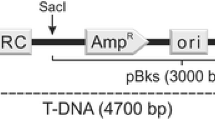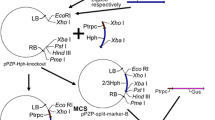Abstract
Grosmannia clavigera is a fungal pathogen associated with the mountain pine beetle (Dendroctonus ponderosae) which is devastating large areas of western Canada’s conifer forests. This fungus also produces a dark melanin pigment that discolors pine sapwood. We have generated the draft genome of G. clavigera. However, functional characterization of genes identified in the genome sequence requires an efficient gene disruption method. In this work, we report a gene replacement strategy for G. clavigera using the Agrobacterium-mediated transformation in conjunction with linear or split-marker deletion cassettes. In addition, we used long flanking regions up to 3 kb from both sides of the targeted genes in our deletion cassettes. We assessed this gene disruption method with two genes from the melanin biosynthesis pathway that produce easily detectable white and red/brown mutant phenotypes: polyketide synthase and scytalone dehydratase. The approach yielded G. clavigera gene replacements with homologous recombination rates between 65 and 82%. For filamentous fungi, this is the first report showing that split-markers can be used with Agrobacterium-mediated transformation to generate appropriate mutants. This method can now be applied to efficiently identify genes involved in G. clavigera fungal pathogenicity and will facilitate understanding how the fungus overcomes the host defence system.



Similar content being viewed by others
References
Bell AA, Wheeler MH (1986) Biosynthesis and functions of fungal melanins. Annu Rev Phytopathol 24:411–451
Catlett NL, Lee B, Yoder OC, Turgeon BG (2003) Split-marker recombination for efficient targeted deletion of fungal genes. Fungal Genet Newsl 50:9–11
Choquer M, Robin G, Le Pêcheur P, Giraud C, Levis C, Viaud M (2008) Ku70 or Ku80 deficiencies in the fungus Botrytis cinerea facilitate targeting of genes that are hard to knock out in a wild-type context. FEMS Microbiol Lett 289:225–232
Colot HV, Park G, Turner GE, Ringelberg C, Crew CM, Litvinkova L, Weiss RL, Borkovich KA, Dunlap JC (2006) A high-throughput gene knockout procedure for Neurospora reveals functions for multiple transcription factors. Proc Natl Acad Sci USA 103:10352–10357
DiGuistini S, Ralph SG, Lim YW, Holt R, Jones S, Bohlmann J, Breuil C (2007) Generation and annotation of lodgepole pine and oleoresin-induced expressed sequences from the blue-stain fungus Ophiostoma clavigerum, a Mountain Pine Beetle-associated pathogen. FEMS Microbiol Lett 267:151–158
DiGuistini S, Liao NY, Platt D, Robertson G, Seidel M, Chan SK, Birol I, Holt RA, Hirst M, Mardis E, Marra MA, Hamelin RC, Bohlmann J, Breuil C, Jones SJM (2009) De novo genome sequence assembly of a filamentous fungus using Sanger, 454 and Illumina sequence data. Genome Biol 10:R94
El-Khoury R, Sellem CH, Coppin E, Boivin A, Maas MF, Debuchy R, Sainsard-Chanet A (2008) Gene deletion and allelic replacement in the filamentous fungus Podospora anserine. Curr Genet 53:249–258
Fairhead C, Llorente B, Denis F, Soler M, Dujon B (1996) New vectors for combinatorial deletions in yeast chromosomes and for gap-repair cloning using ‘split-marker’ recombination. Yeast 12:1439–1457
Fu J, Hettler E, Wickes BL (2006) Split marker transformation increases homologous integration frequency in Cryptococcus neoformans. Fungal Genet Biol 43:200–212
Giaever G, Chu AM, Ni L et al (2002) Functional profiling of the Saccharomyces cerevisiae genome. Nature 418:387–391
Hausner G, Reid J, Klassen GR (2000) On the phylogeny of members of Ceratocystis s.s. and Ophiostoma that possess different anamorphic states, with emphasis on the anamorph genus Leptographium, based on partial ribosomal DNA sequences. Can J Bot 78:903–916
Hoffman B, Breuil C (2004) Disruption of the subtilase gene, albin1, in Ophiostoma piliferum. Appl Environ Microbiol 70:3898–3903
Howard RJ, Valent B (1996) Breaking and entering: host penetration by the fungal rice blast pathogen Magnaporthe grisea. Annu Rev Microbiol 50:491–512
Jeong JS, Mitchell TK, Dean RA (2007) The Magnaporthe grisea snodprot1 homolog, MSP1, is required for virulence. FEMS Microbiol Lett 273:157–165
Kent WJ (2002) BLAT—the BLAST-like alignment tool. Genome Res 12:656–664
Krappmann S (2007) Gene targeting in filamentous fungi: the benefits of impaired repair. Fungal Biol Rev 21:25–29
Kubo Y, Takano Y, Endo N, Yasuda N, Tajima S, Furusawa I (1996) Cloning and structural analysis of the melanin biosynthesis gene SCD1 encoding scytalone dehydratase in Colletotrichum lagenarium. Appl Environ Microbiol 62:4340–4344
Lee S, Kim JJ, Breuil C (2003) A PCR-RFLP marker distinguishing Ophiostoma clavigerum from morphologically similar Leptographium species associated with bark beetles. Can J Bot 81:1104–1112
Lee S, Hamelin R, Six D, Breuil C (2006) Genetic diversity and the presence of two distinct groups in Ophiostoma clavigerum associated with Dendroctonus ponderosae in British Columbia and the Northern Rocky Mountains. Phytopathology 97:1177–1185
Loppnau P, Tanguay P, Breuil C (2004) Isolation and disruption of the melanin pathway polyketide synthase gene of the softwood deep stain fungus Ceratocystis resinifera. Fungal Genet Biol 41:33–41
Ma JC, Zhou Q, Zhou YH, Liao XG, Zhang YJ, Jin D, Pei Y (2009) The size and ratio of homologous sequence to non-homologous sequence in gene disruption cassette influences the gene targeting efficiency in Beauveria bassiana. Appl Microbiol Biotechnol 82:891–898
Massoumi Alamouti S, Tsui CKM, Breuil C (2009) Multigene phylogeny of filamentous ambrosia fungi associated with ambrosia and bark beetles. Mycol Res 113:822–835
Meyer V (2008) Genetic engineering of filamentous fungi-progress, obstacles and future trends. Biotechnol Adv 26:177–185
Michielse CB, Hooykaas PJ, van den Hondel CA, Ram AF (2005) Agrobacterium-mediated transformation as a tool for functional genomics in fungi. Curr Genet 48:1–17
Möller EM, Bahnweg G, Sandermann H, Geiger HH (1992) A simple and efficient protocol for isolation of high molecular weight DNA from filamentous fungi, fruit bodies, and infected plant tissues. Nucleic Acids Res 20:6115–6116
Nielsen ML, Albertsen L, Lettier G, Nielsen JB, Mortensen UH (2006) Efficient PCR-based gene targeting with a recyclable marker for Aspergillus nidulans. Fungal Genet Biol 43:54–64
Ninomiya Y, Suzuki K, Ishii C, Inoue H (2004) Highly efficient gene replacements in Neurospora strains deficient for nonhomologous end-joining. Proc Natl Acad Sci USA 101:12248–12253
Plattner A, DiGuistini S, Breuil C (2008) Variation in pathogenicity of a mountain pine beetle-associated blue-stain fungus, Grosmannia clavigera, on young lodgepole pine in British Columbia. Can J Plant Pathol 30:457–466
Snoek IS, van der Krogt ZA, Touw H, Kerkman R, Pronk JT, Bovenberg RA, van den Berg MA, Daran JM (2009) Construction of an hdfA Penicillium chrysogenum strain impaired in non-homologous end-joining and analysis of its potential for functional analysis studies. Fungal Genet Biol 46:418–426
Solheim H, Krokene P (1998) Growth and virulence of mountain pine beetle associated blue-stain fungi, Ophiostoma clavigerum and O. montium. Can J Bot 76:561–566
Tanguay P, Breuil C (2003) Transforming the sapstaining fungus Ophiostoma piceae with Agrobacterium tumefaciens. Can J Microbiol 49:1–4
Villalba F, Collemare J, Landraud P, Lambou K, Brozek V, Cirer B, Morin D, Bruel C, Beffa R, Lebrun MH (2008) Improved gene targeting in Magnaporthe grisea by inactivation of MgKU80 required for non-homologous end joining. Fungal Genet Biol 45:68–75
Walther A, Wendland J (2008) PCR-based gene targeting in Candida albicans. Nat Protoc 3:1414–1421
Wang HL, Kim SH, Siu H, Breuil C (1999) Transformation of sapstaining fungi with hygromycin B resistance plasmids pAN7–1 and pCB1004. Mycol Res 103:77–80
Wang HL, Kim SH, Breuil C (2001) A scytalone dehydratase gene from Ophiostoma floccosum restores the melanization and pathogenicity phenotypes of a melanin-deficient Colletotrichum lagenarium mutant. Mol Genet Genomics 266:126–132
Weld RJ, Plummer KM, Carpenter MA, Ridgway HJ (2006) Approaches to functional genomics in filamentous fungi. Cell Res 16:31–44
Wendland J (2003) PCR-based methods facilitate targeted gene manipulations and cloning procedures. Curr Genet 44:115–123
You BJ, Lee MH, Chung KR (2009) Gene-specific disruption in the filamentous fungus Cercospora nicotianae using a split-marker approach. Arch Microbiol 91:615–622
Zipfel RD, de Beer ZW, Jacobs K, Wingfield BD, Wingfield MJ (2006) Multi-gene phylogenies define Ceratocystiopsis and Grosmannia distinct from Ophiostoma. Stud Mycol 55:75–97
Zwiers LH, De Waard MA (2001) Efficient Agrobacterium tumefaciens-mediated gene disruption in the phytopathogen Mycosphaerella graminicol. Curr Genet 39:388–393
Acknowledgments
We would like to thank Philippe Tanguay (Laurentian Forestry Centre, Québec) for discussion about AMT, Gordon Robertson (B.C. Cancer Agency Genome Sciences Centre) for suggestions that improved the manuscript, and Huang-Ju Chen for technical assistance. This work was supported by grants to CB and JB from the Natural Sciences and Engineering Research Council of Canada (NSERC) and funds to CB and JB for the Tria Project (http://www.thetriaproject.ca) provided by the Province of British Columbia through Genome British Columbia, by the Government of Alberta through Genome Alberta, and by Genome Canada.
Author information
Authors and Affiliations
Corresponding author
Additional information
Communicated by J. Heitman.
Rights and permissions
About this article
Cite this article
Wang, Y., DiGuistini, S., Wang, TC.T. et al. Agrobacterium-meditated gene disruption using split-marker in Grosmannia clavigera, a mountain pine beetle associated pathogen. Curr Genet 56, 297–307 (2010). https://doi.org/10.1007/s00294-010-0294-2
Received:
Revised:
Accepted:
Published:
Issue Date:
DOI: https://doi.org/10.1007/s00294-010-0294-2




